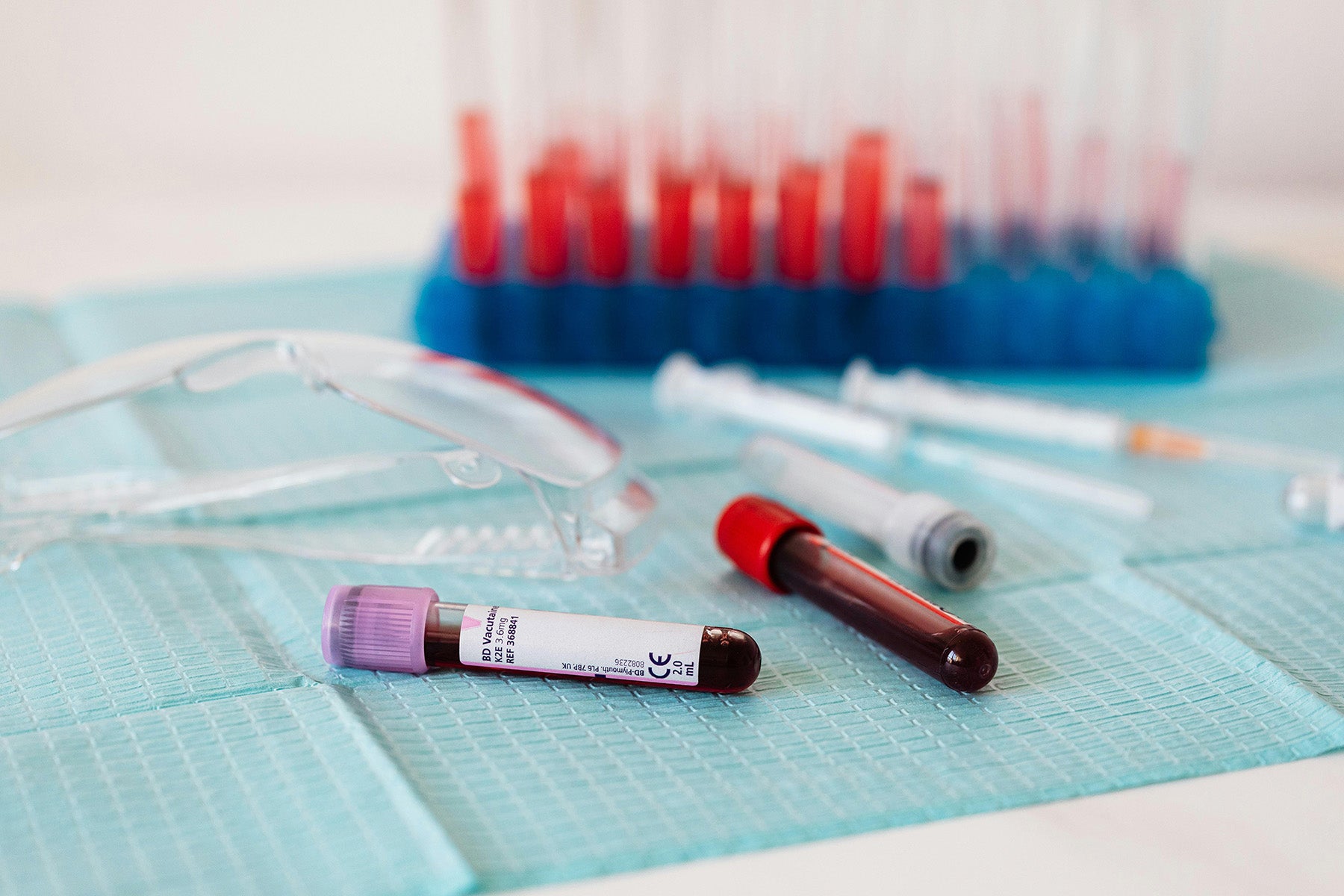
According to ancient tradition, blood is considered the seat of life. Our ancestors attributed magical powers, noble lineage, or decisive character traits to it. They spoke of bad blood, blue blood, or strong blood and defined it as one of the four vital fluids.
Even though their apparent
Our blood is undeniably one of the most important substances in our body. Therefore, its functioning and survival depend on the correct composition of our blood.
But what happens when the balance of blood cells is disrupted? And how do we even know that our blood values are getting out of control?
The answer to this is quite simple: By regularly checking the blood values as part of a small blood count. And we at
Indications for a laboratory analysis
The complete blood count is one of the most frequently doctor-ordered preventive examinations. The reason for this is that many diseases lead to specific changes in the number or ratio of blood cells, making the laboratory values very informative.
Therefore, it is performed both as part of the normal routine examination and for targeted diagnostics in symptomatic complaints. The most common reasons for ordering a complete blood count include the following indications:
• Inflammations and infections
• Anemia (low blood count)
• Polycythemia (increased number of red blood cells)
• Leukemia (increased number of white blood cells)
• Tumors
• Blood clotting disorder
• Monitoring of drug therapy
• Preoperative examination
In addition, a small blood count is often ordered for differential diagnosis when nonspecific symptoms are present. This is the case, for example, when the patient complains of recurring or persistent fatigue, lack of drive, shortness of breath, exhaustion, headaches, concentration problems, sleep disorders, loss of appetite, or dizziness. A complete blood count, on the other hand, is prescribed when there is a suspicion of an infection, as the different leukocytes are examined in this context.
Understanding Laboratory Values: Parameters of the Complete Blood Count
A small blood count provides the doctor with an overview of the number of individual blood cells. In this standard examination, the red blood cells (erythrocytes), white blood cells (leukocytes), and platelets (thrombocytes) are measured. Additionally, other laboratory values (MCV, MCHC, and MCH) are measured by the proportion of red blood pigments (hemoglobin) and the volume proportion of red blood cells (hematocrit).
Ery or RBC:
Red blood cells, which transport oxygen to our cells and carry carbon dioxide back to the lungs.
Leuk or WBC:
White blood cells, which are responsible for defending against pathogens.
Thrombo, PLT or THRO:
Platelets, which are involved in blood clotting and wound healing.
Hk, Hct or Hkt:
Hematocrit value, which represents the ratio between liquid (blood plasma) and solid (blood cells) components in the blood.
Hg, Hgb or Hb:
Hemoglobin, which has the task of binding oxygen and carbon dioxide in the blood.
MCH, MCHC, and MCV:
Various values that describe the characteristics of red blood cells in more detail.
Retis, Retr:
Reticulocytes, which indicate whether a process is in its initial stage or is already subsiding.
| Parameter | Männer | Frauen |
|---|---|---|
| Erythrozyten | 4,1-5,7 Mio./μl | 3,8-5,0 Mio./μl |
| Leukozyten | 3.700-10.100/μl | 3.700-10.100/μl |
| Thrombozyten | 150.000-361.000/μl | 150.000-361.000/μl |
| Hämoglobin | 13,1-16,8 g/dl | 11,6-15,1 g/dl |
| Hämatokrit | 38-49 % | 34-44 % |
| MCV | 81–99 fl | 81–99 fl |
| MCH | 27–34 pg (1,6–2,1 fmol) | 27–34 pg (1,6–2,1 fmol) |
| MCHC | 32–36 g/dl (19,8–22,3 mmol/l) | 32–36 g/dl (19,8–22,3 mmol/l) |
A small blood test provides the doctor with an overview of the number of individual blood cells. In this standard examination, the red blood cells (erythrocytes), white blood cells (leukocytes), and platelets (thrombocytes) are measured. Additionally, other laboratory values (MCV, MCHC, and MCH) are measured, which describe the proportion of red blood pigments (hemoglobin) and the volume proportion of red blood cells (hematocrit).
• Ery or RBC: Red blood cells that transport oxygen to our cells and carbon dioxide back to the lungs.
• Leuk or WBC: White blood cells responsible for defending against pathogens.
• Thrombo, PLT, or THRO: Platelets involved in blood clotting and wound healing.
• Hk, Hct, or Hkt: Hematocrit value, which represents the ratio between liquid (blood plasma) and solid (blood cells) components in the blood.
• Hg, Hgb or Hb: Hemoglobin, which has the task of binding oxygen and carbon dioxide in the blood.
• MCH, MCHC, and MCV: Various values that describe the properties of red blood cells in more detail.
• Retis, Retr: Reticulocytes, which indicate whether a process is still in the early stages or has already subsided.

Next steps: Conclusion on common diseases
Abnormal blood values do not necessarily indicate a disease. Often, the reason for the anomaly is much more trivial: daily fluctuations, medications, stress, physical exertion, alcohol, meals, menstruation, and pregnancy can also influence this. To keep the error rate as low as possible, you should come to the blood test fasting and inform your doctor about all potential interfering factors. Other minor causes include temporary vitamin and iron deficiencies or acute infections, which can also lead to fluctuations in blood values. However, both causes can often be easily remedied, either by the infection subsiding automatically or by prescribing replacement medications (e.g., iron supplements). Abnormal blood values do not always have to prove a disease, but they can be an important diagnostic tool for it.If the measured blood values are outside the reference range, this may indicate the following causes:
| Parameter | zu niedrige Werte | zu hohe Werte |
|---|---|---|
| Erythrozyten |
|
|
| Leukozyten |
|
|
| Thrombozyten |
|
|
| Hämoglobin |
|
|
| Hämatokrit |
|
|
| MCV |
|
|
| MCH |
|
|
| MCHC |
|
|

Costs & Procedure of a Blood Draw
If there is a medical reason to create a blood count, the costs are usually covered by statutory health insurance. The same applies to general preventive examinations (such as the U-examination, the J-examination, and the basic check every three years from the age of 35), which also include a small blood count.
However, it is different for self-payers who want to check their health status without specific indicators. Here, the costs for a small blood count amount to approximately 100 €, including the laboratory analysis, transport costs, medical evaluation, and discussion of findings.
The blood sample is usually taken in the morning so that the last meal was at least eight hours ago. An appointment is made with the general practitioner, specialist, or other trained professional for this purpose.Because the blood sample can be taken not only in the doctor's office but also in pharmacies, medical laboratories, or blood collection points of the Red Cross.
The actual blood collection usually takes only a few minutes. The blood is drawn from the crook of the arm, the tubes are labeled with the customer's data, and the sample is then sent to the laboratory. After about one to two days, the doctor receives the results and can discuss them with the patient at a follow-up appointment. In this process, blood values that exceed the reference range are examined more closely, and any resulting possible follow-up examinations are clarified.
Conclusion: The complete blood count as an important reflection of your health
The extraction of the small blood count is a simple step that can achieve a lot. It can be used to check the state of health, find the cause of possible complaints, and initiate timely therapy for diseases.
For acute complaints as well as regular preventive examinations, it is therefore of enormous importance. The only problem is often that this seemingly small step is associated with so much unnecessary effort. We at
This is especially beneficial for self-payers who are symptom-free and want to stay that way. We help them to make regular blood tests more uncomplicated, faster, and more flexible.For this purpose, we work closely with doctors and accredited laboratories to review the evaluations and thus detect diseases earlier.
With the help of the software, the results can be accessed on the smartphone regardless of location and time, significantly reducing travel, waiting times, and phone calls for result discussions.
This allows you to check your health even more easily and recover even faster.









